The Good Sleeping Posture Guide
An adjustable bed can help you find a good sleeping posture, but what do we mean by a ‘correct’ or a ‘healthy’ sleeping posture? This guide will explain all.
What are the most common sleeping positions?
We all have our own preferred ways of sleeping and what’s best for one individual might be completely different for another. Here though are some of the most common sleeping positions:
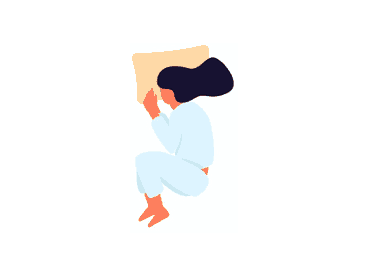
The foetus
One of the most common and comforting sleeping positions is the foetus. This involves resting on your side with your arms out and your legs slightly bent. If you prefer this way of lying down, you’re in luck as it’s effective at keeping the muscles, discs and ligaments in your back in an optimal position. It also helps you to breathe freely and can reduce the risk of acid reflux.
To get the most out of this position, simply place a pillow between your knees. Also, if you have a soft mattress or an hourglass figure, it helps to put a pillow under your waist. Make sure your arms stay stretched out in front of you too, so they don’t lose circulation.
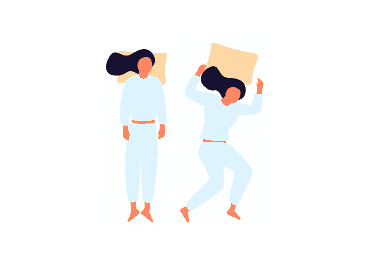
The soldier/starfish
Lying on your back in the soldier position (legs in line and your arms by your side) or in the starfish (legs and arms outstretched), can increase your risk of snoring and heartburn.
If you sleep in either of these positions, placing pillows under your knees can help relieve the pressure on your lower back – although an adjustable bed can help you achieve the same effect more easily.
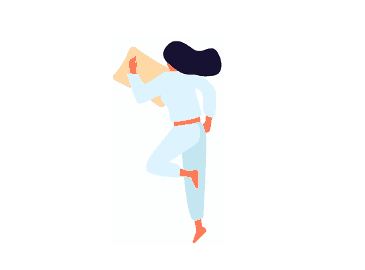
The freefaller
Lying on your front in the freefaller (or skydiver) position can lead to stiffness in your neck and pins and needles in your hands. However, you can reduce the strain on your neck with a pillow under one side of your torso.
Which sleeping positions are bad for you?
Spinal support is vital to restful and healthy sleep. Your spine is an ‘S’-shaped curve, so when you lie on your back, you put pressure on areas that are not supported, such as the lower back. Research has shown that certain health issues can be linked to sleeping positions.
Lying flat, without full support for your spine, can strain specific muscles for periods and their tension can gradually pull your spine out of alignment. Because each section of your spine maintains different bodily functions, misalignment can result in a vast array of symptoms and conditions. Experts agree that lying flat in bed can be linked to pulmonary, cardiovascular, gastro-intestinal, musculo-skeletal and psychological issues.
Back pain sufferers often pile pillows up in search of relief, but this can put your neck in awkward positions, leading to stiffness and muscle strain. Others find that sleeping on their side can prevent neck and back pain, as well as reducing digestive problems and snoring. Despite this, we often shift position while sleeping to relieve the pressure caused by having our body weight pushed to one side.
This is where the smooth contouring of an Adjustamatic adjustable bed can help: enabling you to easily change your sleeping position for maximum comfort and postural health benefits.
What is the best sleeping position for posture?
Experts generally agree that a good sleeping posture is one that holds the ‘midline’ (below). This is a term used by physiotherapists, which refers to maintaining your spine’s natural curves as you sleep, thus reducing strain on your back.
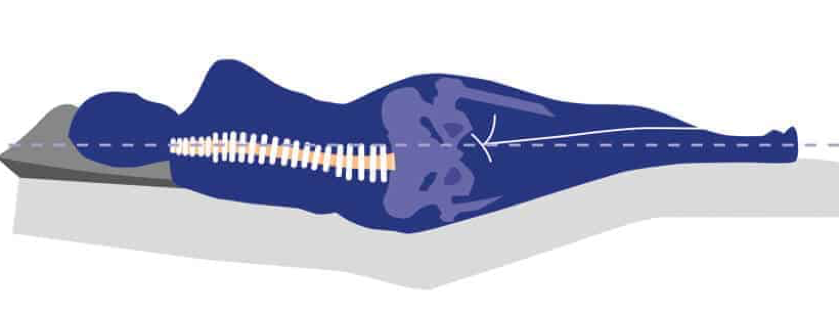
How to maintain good posture while sleeping
To achieve the best sleeping position for posture, it’s best to think about positions more suited to the contours of your spine. However, this isn’t easy with a flat bed. The ideal and most comfortable sleeping posture is one we call the ‘zero gravity’ position (below), which eliminates pressure points on the spine.

With an adjustable bed, you can adjust your sleeping position to support and reduce tension on these pressure points. This ‘soft contour’ position will take the strain off the spine and pivot point joints giving you as close a position as possible to zero gravity.
Our adjustable beds are renowned for their ability to adapt to individual needs. So, if you happen to share a bed with someone who has different support needs to yours, we have that covered too with split or ‘dual’ mattresses, each independently controlled but built in one bed frame.
Sleeping positions that can relieve back pain, spinal stenosis and sciatica
Spinal Stenosis
Spinal Stenosis is a term used to describe a narrowing of the spinal canal which can result in back pain. Sleeping in the foetal position can alleviate the pain caused by compression of the spinal cord. For extra comfort, sleep with the head and knees elevated.
Sciatica
As a result of Sciatica, pressure on the sciatic nerve can be very painful, but with an adjustable bed you can apply the soft contour position for optimum support, keeping your back flatter to the ground. By supporting the base of the spine, it is possible to keep the spine aligned and help to prevent trapped nerves and release those that are currently trapped.
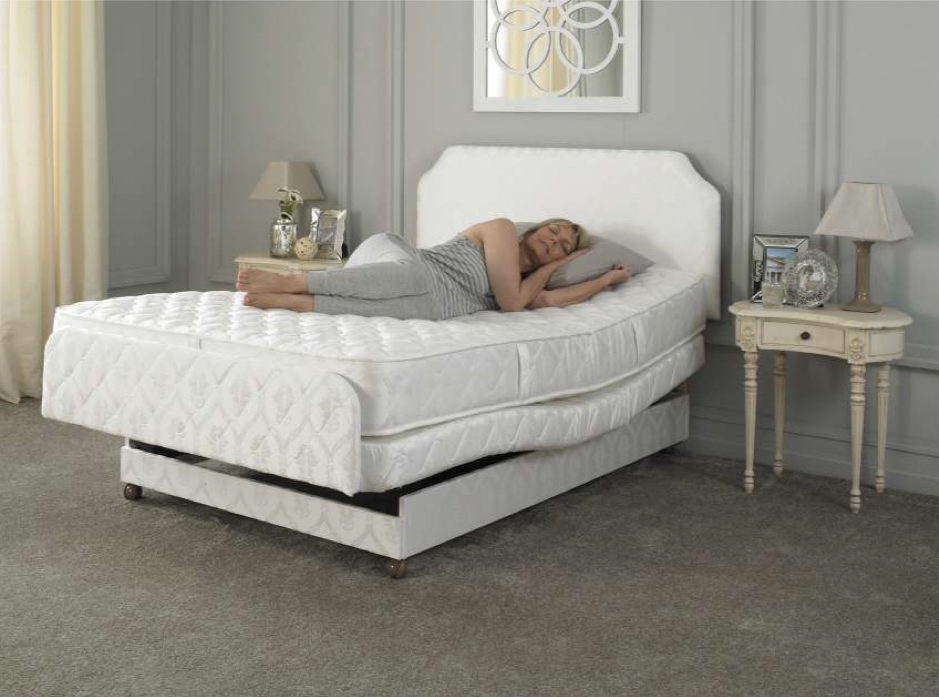
Sleeping positions that improve blood pressure and heart function
Heart problems can cause swelling of the ankles and feet. Swollen ankles can also be a side effect of some blood pressure medicines, in particular calcium channel blockers. Using an adjustable bed to elevate the legs into a raised position can help circulation and reduce this swelling.
If having raised legs when lying down gives you shortness of breath, try raising the head end of the bed also to the foetal position. This takes pressure off the chest and heart whilst improving lower leg drainage.
Raising the head end of the adjustable bed will relieve pressure on the chest and heart. This improves breathing by delivering more oxygen to the body and prevents the heart from working harder to deliver oxygen and blood to vital organs.
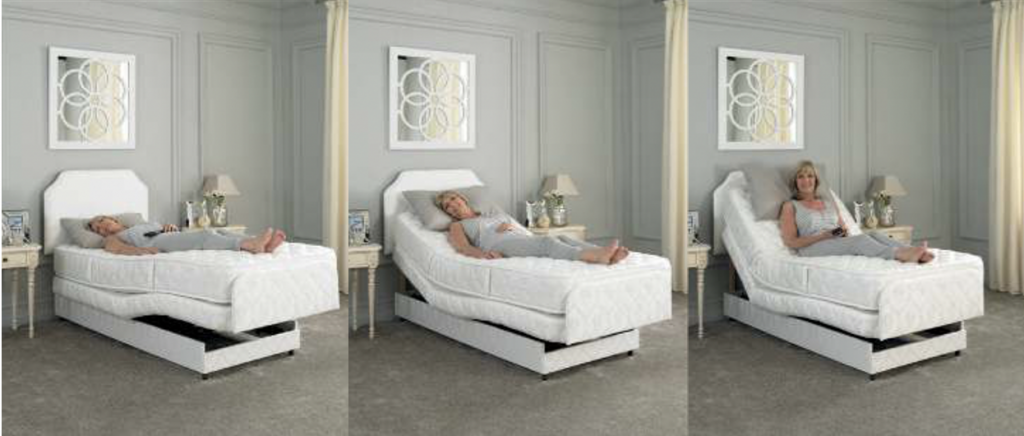
Sleeping positions that improve breathing
Snoring and sleep apnoea
Lifting the head up and sleeping at a slight incline can change the effect that gravity has on the neck, drastically reducing snoring and instances of sleep apnoea. Medical research has shown that sleeping in a more upright position like this improves the airflow in the airways which thus improves oxygen in the blood.
Chronic Obstructive Pulmonary Disease
Chronic Obstructive Pulmonary Disease (COPD) is one of the most common respiratory diseases in the UK. An adjustable bed’s appropriate posture positioning may help relieve the symptoms of COPD. For example, elevating the head of the bed by 45 degrees allows the diaphragm to expand to improve respiratory function and reduce pulmonary venous congestion.
General chest congestion
Increasing the incline of the head end of the adjustable bed can improve breathing and prevents the heart from working harder to deliver oxygen and blood to vital organs, as well as keeping sinus and lungs clear.
Sleeping positions that improve circulation
Swelling of the ankles and feet (or oedema) affects 30% of the population. Lower limb swelling can cause heaviness in the legs, itching, throbbing. muscle cramps and pain.
Using an adjustable bed by raising your legs above the level of the heart will help to reduce lower leg, ankle and feet swelling; improving microcirculation and oxygen delivery. In medical trials, leg elevation acting against gravity increased blood flow within veins by 45% and reduced lower leg swelling.
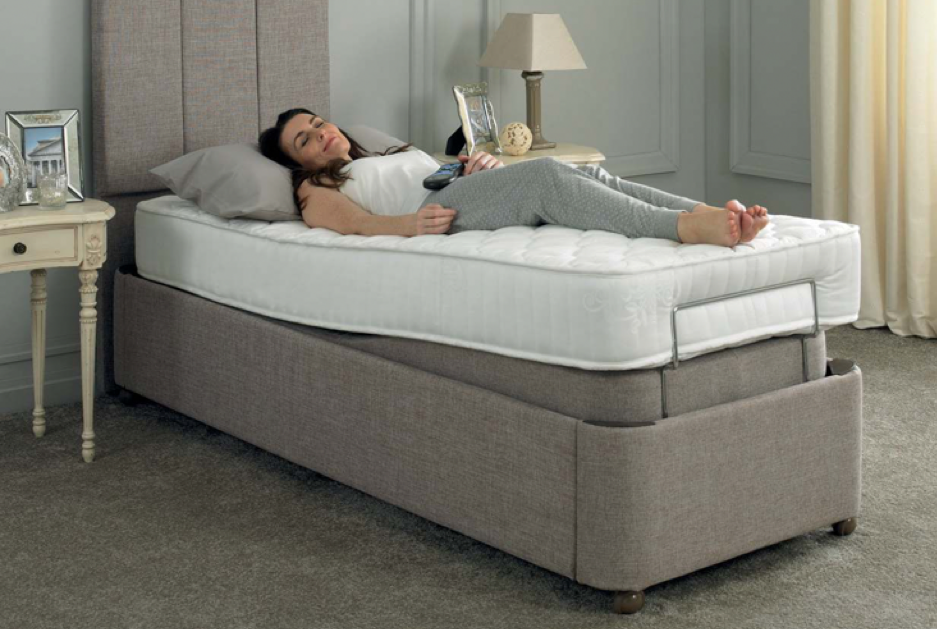
Sleeping positions that improve digestion
Using your adjustable bed to improve posture will help with digestion at night and while sleeping. If a person is lying completely flat, the effects of gravity are seriously impeding digestion. However, sleeping at an incline can help the body to better digest food that is still in the stomach. If your head is elevated, your stomach will be below your oesophagus, so acid or food will stay in your digestive system.
Sleeping positions that reduce arthritic pain
For arthritis of the hips and knees
Sleeping with the lower legs raised will take pressure off the lower spine and hips or the soft contour position of your adjustable bed can relieve joint compression.
For osteoarthritis
The most comfortable sleeping position for this condition is the foetal position, which takes pressure off the joints in the spine. Sleeping with your legs elevated can also help relieve the pressure.
For arthritic spine
Adjusting your sleep posture with the finite controls of an adjustable bed will help to take away the compression forces on arthritic joints to give relief.
Sleeping positions that improve heartburn/acid reflux
On a flat bed, acid can move to the oesophagus leading to episodes of reflux (also known as heartburn). Buying an adjustable bed to raise yourself into an inclined position allows gravity to work against acid reflux helping the stomach to retain the acids – helping you get a full night’s sleep.
If you are interested in buying one of our adjustable beds to help improve your posture and any symptoms, please don’t hesitate to give us a call on 0800 689 9823 (9am-5pm Mon-Fri), or drop us a message to get a quote. We can also organise a home visit for you to trial any bed, as well as give you professional and reliable advice. Adjustamatic provides 0% financing options and you may be eligible for a VAT exempt adjustable bed.


